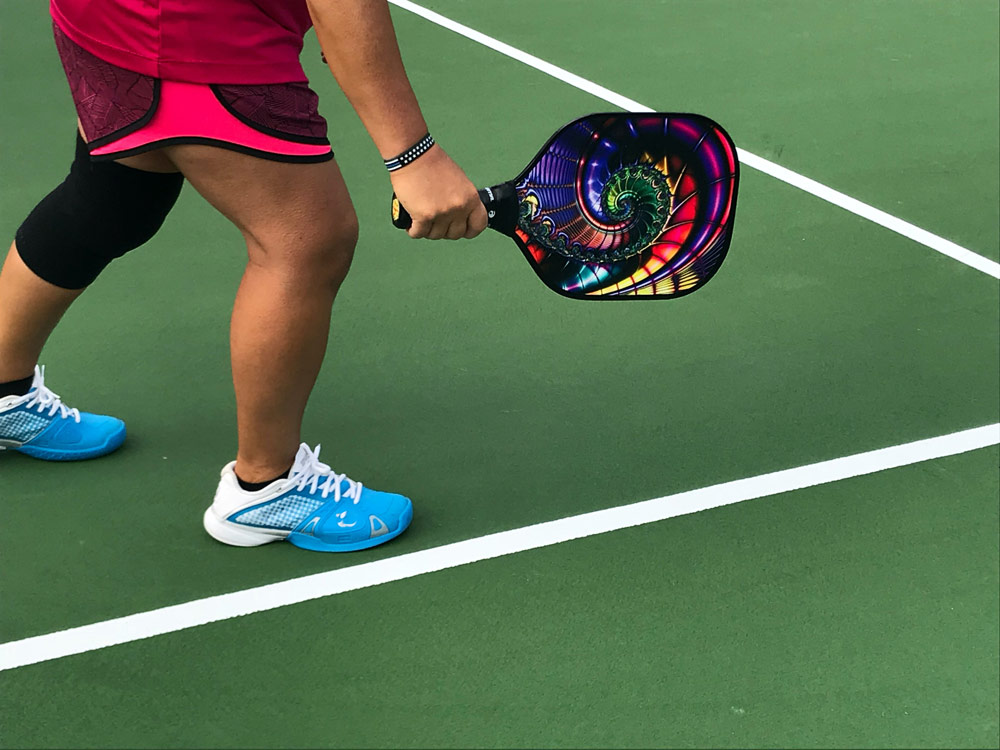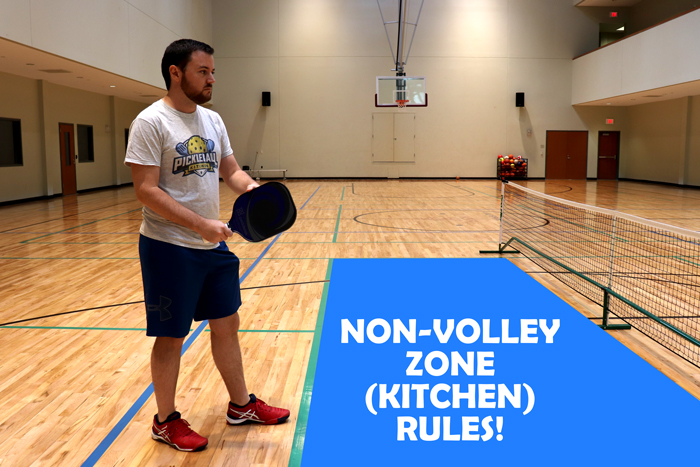Melvin is an expert for portable products.The site is for sharing everything about portable products for online buyers.
The Kitchen in pickleball is called so because it refers to the non-volley zone located near the net. This designated area is crucial for pickleball strategy and gameplay.
Pickleball, a popular paddle sport, combines elements of tennis, badminton, and ping pong. The Kitchen, also known as the non-volley zone, is a 14-foot area on either side of the net where players are not allowed to hit the ball out of the air.
Known as the heart of the game, the Kitchen restricts players from executing volleys near the net, promoting strategic drop shots, dinks, and soft shots. Staying out of the Kitchen is vital during fast-paced rallies, as stepping into this area and volleying can lead to a fault. This unique concept in pickleball helps foster balanced gameplay and emphasizes precise shot placement.
The Origin Of The Term ‘kitchen’ In Pickleball
Early references to the kitchen in pickleball can be traced back to the origins of the game. The term ‘kitchen’ in pickleball refers to a specific area of the court that players need to be careful around. It is located on both sides of the net, extending 7 feet out from the net on each side. The kitchen is often referred to as a ‘non-volley zone’, as players are not allowed to hit the ball from this area if they are volleying. This rule was put in place to prevent players from dominating the game at the net and encourage more strategic gameplay.
The history behind the term ‘kitchen’ is not entirely clear, but one theory suggests that it got its name from the resemblance to a kitchen floor. The smooth surface of the kitchen area, similar to a kitchen’s tiled floor, served as a visual representation of the non-volley zone. Another theory proposes that the term originated from the idea of a kitchen being the heart of a home, and the kitchen in pickleball serves as the heart of the game, highlighting its importance in maintaining fair play and sportsmanship.
The Court And Game Dynamics
Have you ever wondered why the kitchen in pickleball is called the kitchen? Well, let’s dive into the court layout and game dynamics to understand the origins of this term.
The pickleball court is divided into different strategic areas that players need to be familiar with. At the center is the non-volley zone, also known as the kitchen. This area extends 7 feet from the net on both sides and serves as a vital zone for players to employ specific tactics.
Being at the kitchen allows players to strategically position themselves, limiting their opponent’s options to play a powerful shot. It also helps in setting up opportunities for dinking, a soft shot that aims to place the ball close to the net, forcing the opponent into a more challenging position.
Understanding the court layout and the importance of the kitchen in pickleball enables players to employ effective strategies and gain an advantage during the game. So next time you step onto a pickleball court, keep in mind the significance of the kitchen in this exciting sport.
The Kitchen: A Key Strategic Zone
The Kitchen: A Key Strategic Zone
Exploring the purpose of the kitchen
The kitchen, also known as the non-volley zone, is a vital area on a pickleball court. It is a seven-foot space on each side of the net. Its purpose is to prevent players from executing smashes from close range, making the game more challenging and strategic. In the kitchen, players are restricted from volleying the ball before it bounces. This restriction encourages players to use dinks, drop shots, and soft shots to control the pace of the game and set up their shots. Being proficient in kitchen play is essential for a successful pickleball player as it requires quick reflexes, precision, and the ability to control the game tempo.
The role of the player in the kitchen
When a player stands in the kitchen, they need to anticipate and react quickly to the opponent’s shots. They aim to stay in control by performing soft shots that land in the opponent’s half without going out of bounds. The player must be cautious to avoid stepping into the kitchen before the ball bounces. By staying in the kitchen, the player can limit the opponent’s options, forcing them to make more challenging shots. Skillful placement and well-executed shots from the kitchen can help a player gain an advantage in the game.

Credit: pickleplay.com
Dimensions And Boundaries
One of the key aspects of the pickleball court is the kitchen, also known as the non-volley zone. This area is a six-foot section on both sides of the net and extends all the way to the sidelines. The kitchen plays an important role in the game as it restricts players from hitting the ball in the air within this zone. By forcing players to stay out of the kitchen, it promotes a more strategic and controlled style of play.
The specific dimensions of the kitchen vary depending on the type of court you are playing on. In most cases, the kitchen is marked by a solid line on both sides of the net. These lines run parallel to the net and extend all the way to the sidelines. Some courts may also have diagonal lines extending from the kitchen lines to the sidelines, indicating the boundaries of the non-volley zone.
| Type of Court | Kitchen Dimensions |
|---|---|
| Outdoor Court | 10 feet deep from the net |
| Indoor Court | 7 feet deep from the net |
It is crucial for players to be aware of the specific boundaries of the kitchen on the court. Stepping into the non-volley zone while hitting the ball results in a fault, giving the opposing team a point. This rule encourages players to stay out of the kitchen and utilize more strategic shots to gain an advantage in the game.
Rules And Restrictions
The kitchen is an essential area in the game of pickleball, contributing to the strategic nature of the sport. This specific area on the court is commonly referred to as the non-volley zone or NVZ. Understanding the rules and restrictions associated with the kitchen is imperative for players to participate effectively and avoid penalties.
One crucial rule regarding the kitchen is the prohibition of volleys inside this space. Players must ensure that they do not hit the ball while standing inside the kitchen unless the ball has bounced outside this zone. Violating this rule results in a fault and the opposing team gets a point. Another restriction is that players cannot step into the kitchen while hitting the ball, resulting in a fault as well.
Common faults related to the kitchen include hitting the ball before it bounces in the kitchen, stepping into the kitchen while executing a shot, or volleying the ball while standing inside it. These faults can result in penalties, such as the loss of the serve or a point for the opposing team.
The Debate: Other Names For The Kitchen
One of the most debated topics in pickleball is why the non-volley zone is called the Kitchen. While it is universally accepted that the term originated from the game’s inventor, Joel Pritchard, there has been ongoing discussion about alternative names for this area of the court. Some players argue that calling it the no-volley zone or simply the non-volley area would be more straightforward and less confusing for new players. Others prefer terms like the dink zone or the transition zone, which highlight the strategic importance of this area. However, despite these alternative suggestions, the Kitchen remains the most commonly used term in pickleball. Its quirky name adds a touch of fun and uniqueness to the game, creating a sense of camaraderie among players. In conclusion, while alternative names have their merits, the Kitchen continues to be the preferred term for this crucial area on the pickleball court.
Frequently Asked Questions Of Why Is It Called The Kitchen In Pickleball
Why Is It Called The Kitchen In Pickleball?
The term “kitchen” in pickleball refers to the non-volley zone located near the net. When the game was first played, players would hit the ball into the kitchen and have to “cook” their shot before stepping into the non-volley zone to hit it.
The name stuck and has been used ever since.
What Is The Purpose Of The Kitchen In Pickleball?
The kitchen in pickleball serves as a restriction zone where players are not allowed to hit the ball out of the air (volley) unless they are behind the kitchen line. This rule encourages more strategic play and prevents players from dominating the net, creating a more balanced and competitive game.
Can You Step On The Kitchen Line In Pickleball?
Yes, you are allowed to step on the kitchen line in pickleball as long as you do not touch or enter the non-volley zone with any part of your body or paddle. Stepping on the kitchen line is not considered a fault, but stepping into the kitchen is against the rules and will result in a point for your opponents.
What Happens If You Hit The Ball From The Kitchen In Pickleball?
If you hit the ball while any part of your body or paddle is touching or inside the kitchen, it is considered a fault. The opposing team will be awarded a point, and the serve will be given to the other team.
It is important to stay behind the kitchen line when hitting the ball to avoid this penalty.
Conclusion
The term “kitchen” in pickleball refers to a specific area on the court that players aim to avoid. It is located at the non-volley zone and is known as a challenging spot to play from. Understanding the origins and significance of this word adds depth to the game of pickleball and enhances our overall appreciation for the sport.
So next time you step onto the court, keep the kitchen in mind and strive to keep your game free from the dreaded “kitchen” mistakes.

Melvin is an expert for portable products.The site is for sharing everything about portable products for online buyers.

